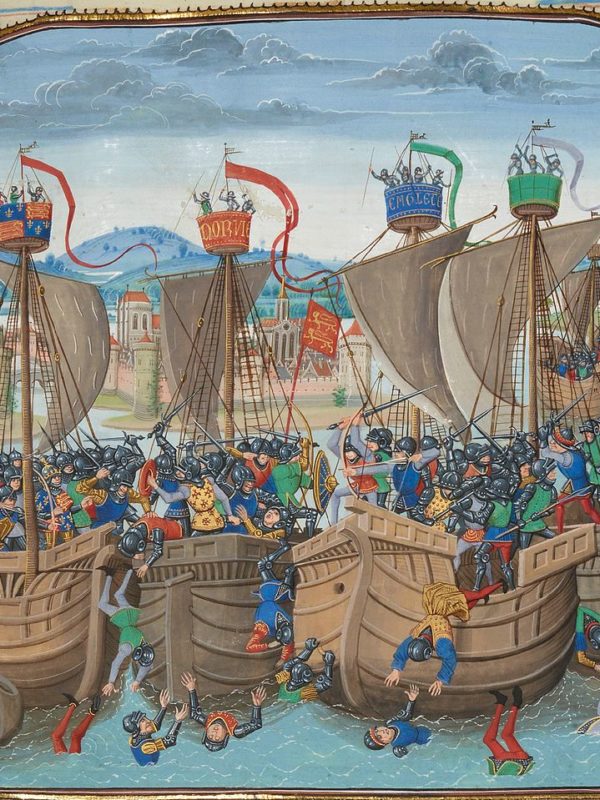A naval battle, fought just outside the port of Sluys (in modern day Zeeland, in the Netherlands) between Edward III’s fleet and that of King Philippe VI of France’s, had a significant impact on the Channel Islands .
France and England had been at war since November 1337 in what would become known as the Hundred Years War. The war had started as a result of King Philippe wishing to take control of Gascony in south-western France which at the time was controlled and ruled by Edward III. On the pretext that Edward III had repeatedly not complied with his obligations as vassal to Philip VI as the King of France, Philippe declared war.
During war in this period, any territory or port of the enemy was a target and could and would be attacked. Here the French, at the beginning of the war at least, had the advantage of access to ships which were better suited to these raiding tactics. They had shallow drafted galleys rowed by large crews and were ideal for attacking towns and ports and not being reliant on tides and weather.
The English on the other hand adopted a different approach. Edward III only had three ships in his “navy” and relied upon commandeering merchant vessels (normally deep drafted single-masted “cogs”). Modifications were made to them by adding fore and aft-castles to carry troops who would fire upon enemy vessels from them, as well as crow’s nests.
By 1340, the French tactics were proving themselves. They raided the south coast of England repeatedly with considerable success, which resulted in Edward losing two out of three of his personal ships.
Jersey was also attacked in this period of two years. In March 1338, Nicholas Behuchet, Admiral of France, occupied Jersey for six months and “devastated” the Island whilst here. He attacked Gorey Castle but failed to breach its stout walls built directly on its rocky promontory overlooking the French coast.
The following year, Sir Robert Bertrand, Marshall of France, invaded Jersey. Again, Gorey Castle was besieged during the summer months and again the French forces left Jersey at the end of the campaigning season unsuccessful.
Whilst the Castle hadn’t been captured, property all over the island had been destroyed, civilians killed, and crops and other possessions being stolen by the French forces.
Incidentally, Guernsey had fared less well, also having been completely occupied in 1339 with the main fortress Castle Cornet having been lost. The French were driven out of Guernsey in the following year but nonetheless retained control of and occupied Castle Cornet, which sits just outside the port of St Peter Port, for another five years.
A major invasion was Edward III’s answer to all these French attacks. He gathered his fleet, with his armies aboard, with a view to landing in Bruges and linking up with allies against Philippe. Edward was aboard his flagship to lead his forces. After leaving England on the 22 June 1340, he found the French forces blocking his entry to the estuary just outside of the coastal town of Sluys. (Interestingly, modern day Sluys (or Sluis) is 6 kilometres inland, the estuary having silted up over the years)
With the French having lined up their fleet across the estuary, the high sided English ships had the advantage of being able to fire down into the shallow drafted French vessels. The result of the battle was an overwhelming victory for the English. The French lost some 24 ships sunk, 166 ships captured and somewhere between 16,000 to 20,000 killed. Of those killed, it was mainly by drowning and being clubbed to death by the Flemish as they scrambled ashore. Admiral Behuchet (remember him in Jersey two years earlier?) was captured and hung from his own mast.
Edward’s losses were much smaller and were estimated to be in the hundreds. The victory at Sluys allowed Edward to successfully land and besiege Tournai (albeit unsuccessfully). With naval supremacy in the Channel in the years which followed, this allowed Edward’s armies to land in France and campaign on French soil. These campaigns culminated in the victory over the French at Crecy in 1346 and the surrender of the port and town of Calais in 1347 (which was held by the English for the next two hundred years). It also established the English longbow was the dominant weapon across the continent.
The victory at the Battle of Sluys also meant the end of supremacy of the French fleet in the English Channel and a reduction in coastal raiding on the English south coast. The Channel Islands seem to have had less raids from 1340 and Jersey seems to have avoided them completely for this next phase of the war.
In Jersey, this lack of raiding allowed the island to rebuild as well as make better preparations against a French raid, which would surely come at some point when fortunes changed.
It was in this climate that the Seigneurs of St Ouen, are believed to have got permission to build Grosnez Castle on the north-western corner of Jersey. Renauld (Reginald) de Carteret had performed his duties to Edward III by fighting the French from Gorey Castle in 1338-9. His son Philippe, and in turn his son, Renauld, we must assume would have carried on their royal duties when they became seigneurs and been involved in the castle construction.
But once built, Grosnez Castle was not going to survive the ultimate test of its first attack. When the war flared up again in the 1370s, Jersey was attacked in 1373 by the then Constable of France, Bertrand du Guesclin and his lieutenant the Duke of Bourbon, and Grosnez Castle was captured and pulled down by the French.
In conclusion therefore, it just goes to show that an event which happens elsewhere, has an impact here in the Channel Islands, and we shouldn’t always believe that just because something happened here, it was centred here.

